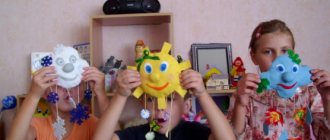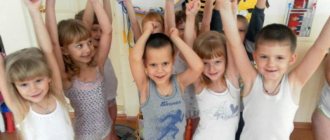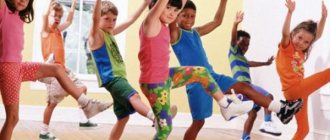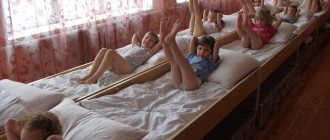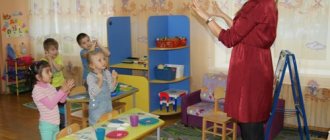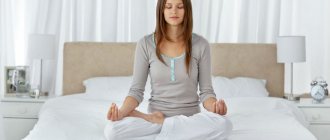Sleep plays a vital role in a child's daily routine. How the baby wakes up depends on his mood, state of health and how he will spend the rest of the day. In kindergarten, organizing a proper awakening is more difficult than for parents at home, because it is necessary for 15, 20, or even 30 people to throw off the shackles of Morpheus almost simultaneously, and to do it correctly. Solving such a problem is not easy, but with knowledge of some methodological nuances it is quite possible.
- 2 Types of gymnastics, or a little about the terms
2.1 Types of exercises
- 4.1 Table: card index of exercises after sleep
4.2.1 Video: gymnastics after waking up (middle group)
- 5.1 Table: sample analysis scheme
Goals, objectives and techniques
Gymnastics after sleep is a set of exercises that provide a smooth transition from calmness to wakefulness.
The objectives of such classes are:
- increase in muscle tone;
- improved mood;
- prevention of colds;
- strengthening the respiratory system;
- preventing the development of problems with posture, flat feet;
- fostering the habit of stretching the body after waking up.
Not only his mood, but also the emotional atmosphere of the entire group depends on how each child wakes up.
To achieve the goals, every day the teacher selects exercises to solve problems such as:
- toning the nervous system (that is, preventing irritability and anxiety that may arise after waking up);
- improving the functioning of the body’s main systems (cardiovascular, respiratory, as well as stabilizing the body’s protective functions);
- creating a positive atmosphere in the group.
All this is possible with the right combination of gymnastics techniques after sleep.
- The plot of the awakening. This technique is especially important for children of the first and second junior groups. The essence of the technique is that all exercises are carried out within the framework of a common plot. For example, a bear came to visit us and asked for help: her son Mishka could not wake up, and he needed to go to help his mother to pick raspberries for the winter - he needed to show by example how to quickly restore the body after sleep. In addition, it will be more interesting for children to perform certain actions accompanied by rhymes and short sayings.
- Musicality. Quiet, relaxing music, played a little louder than before bed, helps children of any age recover.
Gymnastics after waking up should be done to music
- Lying exercises. These complexes help to gradually restore muscle tone and move on to more active actions. Again, for children, more attention is paid to this block of exercises, since the younger the children, the more difficult it is for them to adapt to active activity after sleep.
- Active block of gymnastics (or “mat exercises”). It includes tasks that are performed while standing. The complex includes swinging arms, legs, body turns, squats, walking on massage mats, etc. For children in older groups, tasks such as complexes play a very important role in developing correct posture.
- Breathing exercises. For children of the middle - preparatory groups, this is almost the most important stage of work, since, in addition to the task of general strengthening of the body and the respiratory system in particular, exercises help develop correct sound pronunciation, which is very important for children who are fully mastering speech or those who have problems with the speech apparatus.
More information about gymnastics after sleep in the preparatory group can be found in our article - We conduct gymnastics after sleep in the preparatory group of the kindergarten.
Gymnastics after sleep as one of the components of health-saving technologies
I am not afraid to repeat once again: Taking care of health is the most important work of a teacher. Sukhomlinsky Vasily Alexandrovich
Health is a great gift, without which it is difficult to make life happy, interesting and long. A healthy child is easier to raise, teach and educate. He develops the necessary skills and abilities faster. He adapts better to changing conditions and adequately perceives the demands placed on him. Health is the most important prerequisite for the formation of character, the development of will, and natural abilities. Currently, one of the priority tasks facing teachers is to preserve the health of children in the process of education and training. The methodological development I have presented is aimed at solving this problem. It presents ways to organize and conduct gymnastics after sleep. A consultation for parents has been developed. The formation of a healthy lifestyle should begin in kindergarten. There are no trifles in this matter. All life activities of a child in a preschool institution should be aimed at maintaining and strengthening health. Gymnastics after sleep is one of the most important building blocks in establishing the foundation of children’s health, which can only be strengthened if carried out systematically. It is difficult to overestimate the role of daytime sleep in the physical and intellectual development of a child. He simply needs a rest in the middle of the day. After a nap, children wake up lethargic and have low performance, as muscle tone is relaxed. All organs and systems (cardiovascular, respiratory, nervous, etc.) are not prepared for the stress that the child’s body will have to overcome during activities in the evening. But how can you help children wake up in a good mood and actively continue the day? Do gymnastics with your children after a quiet hour after bedtime. Gymnastics after daytime sleep is a set of activities that facilitate the transition from sleep to wakefulness. Invigorating gymnastics helps the child’s body wake up, improves mood, and improves muscle tone. After good gymnastics, children’s feelings of drowsiness, lethargy, and weakness disappear, mental and physical performance and activity increase, and the child’s mood and well-being improve. Gymnastics after a nap is a hardening procedure. The purpose of such gymnastics is to promote the quick and comfortable awakening of children after sleep. The objectives of gymnastics after sleep:
- increase the tone of the nervous system;
- strengthen muscle tone;
- contribute to the prevention of musculoskeletal disorders;
- help prevent colds;
- development of physical skills;
- maintain positive emotions when performing physical exercises and other routine moments in the afternoon.
Solving these problems allows you to smoothly and at the same time quickly increase the mental and physical performance of the child’s body. Gymnastics after sleep, its organization and implementation . The transition from the sleep state to the waking state occurs gradually. To facilitate the transition from a state of rest after waking up to a state of active wakefulness, you can turn on music. Music has a positive effect on children's emotions, creates a good mood in them, instills cheerfulness and joy, helps the rhythm of movements, and makes them easier to perform. Children learn to listen to music and coordinate movements with its character, to perform movements expressively and smoothly. It’s good if, after waking up, children hear their favorite children’s songs or calm, pleasant music, then they will wake up much faster. Don't forget to smile. The first thing a child should see after sleep is the smiling face of an adult, and also hear smooth, measured speech, pleasant intonations, and diminutive suffixes. Children subtly feel the emotions of others. An adult needs to be attentive to himself, monitor his facial expressions and emotional state. Children absorb the excitement, anxiety, irritability, and uncertainty of an adult immediately, like a sponge. All experiences will immediately affect the children’s mood. Invigorating gymnastics should be carried out in a well-ventilated area for seven to fifteen minutes, depending on the age of the children. A prerequisite for gymnastics is taking into account the individual characteristics of each child. Gymnastics consists of several parts:
- warm-up exercises in bed;
- performing simple self-massage (finger exercises) or acupressure;
- performing general developmental exercises at the crib (breathing exercises);
- walking on massage mats;
- Gymnastics can end with wiping with cold water or dousing (arms or legs).
In addition to general health-improving goals, each of the structural parts of invigorating gymnastics also solves its own narrower, specific tasks: Part I - gymnastics in cribs - gymnastics in bed is aimed at the gradual transition of children from sleep to wakefulness. It is better to spend it with the children who have woken up; the rest join in as they wake up. Gymnastics in bed can include elements such as stretching, alternately and simultaneously raising and lowering the arms and legs, elements of finger gymnastics, eye gymnastics, etc. The main rule is to exclude sudden movements that can cause muscle strain, overexcitation, and blood pressure drop. pressure and, as a result, dizziness. The duration of gymnastics in bed is about 2-3 minutes. Part II - corrective exercises, hardening procedures - is aimed at preventing flat feet and scoliosis, training children in basic movements (walking on toes, heels, on the outer and inner sides of the foot, with high knees, etc.), providing a hardening effect on the body. This part of the gymnastics is carried out in a well-ventilated group room using massage mats made by the children's parents. Part III – the final one – increases the child’s physical and emotional tone, creates a positive emotional mood in the group, and encourages further active activity. It can be carried out on the basis of game-type gymnastics using 3-6 simulation exercises. Gymnastics of a playful nature have a plot, they contain characters familiar to children, who are role models for the movements of birds, animals, plants, and children create various images (“skier”, “skater”, “gymnast”, “parsley”, “flower” and etc.). By adopting a certain play image, children often better understand the technique of performing a particular exercise. Children of middle and senior preschool age are very fond of invigorating gymnastics complexes in the form of musical and rhythmic exercises. Dance movements mobilize physical strength, develop grace and coordination of movements, strengthen muscles, and improve breathing. You can also use complexes with elements of acupressure, self-massage, and finger exercises. The essence of acupressure is reduced to mechanical irritation of biologically active points on the body that increase immunity. Carrying out gymnastics after a nap in a playful way allows you to create a positive emotional background and arouse increased interest in all health procedures. Thus, several problems are solved simultaneously: improving the health of children, developing their motor imagination, and developing meaningful motor skills. And most importantly, all this gives children great pleasure. All exercises are carried out at a free pace, without coercion. Each child performs exercises to the extent that is accessible and enjoyable to him. If a child for some reason does not want to perform an exercise, he can simply observe the execution, or perform it partially. The duration of the gymnastics is 7-12 minutes. This is determined by the age of the children and their state of health. It is advisable to use different versions of invigorating gymnastics throughout the year. Thus, daily performance of a complex of gymnastics, developed taking into account the patterns of functioning of the body after sleep and the individual characteristics of the child’s body, allows you to prepare the body for upcoming mental, physical and emotional stress, is a good means of preserving and strengthening health, preventing flat feet, provides high mental and physical performance during the second half of the day. Gymnastics after a nap increases the child’s overall level of physical activity, reducing the adverse effects of a sedentary lifestyle. A well-designed gymnastics complex does not cause negative emotions, at the same time it improves the mood, well-being and activity of the child, the tone of the central nervous system and increases the overall resistance of the body. The system of invigorating gymnastics built in this way helps the child’s body gradually and gently transition from sleep to active wakefulness with a simultaneous health-improving effect. Consultation for parents. INVOLVING GYMNASTICS AFTER SLEEP We all know the expression “got off on the wrong foot.” The mood that these words characterize is also familiar. Kindergarten teachers strive to ensure that children wake up after a nap in a good mood, cheerful and energetic. And parents should strive for this at home. Awakening is one of the most important moments contributing to the normal course of vital processes for the child. For this purpose, after daytime sleep, invigorating gymnastics is carried out; it is aimed at a gradual transition from sleep to wakefulness. It includes the following elements:
- stretching,
- alternately raising and lowering arms, legs,
- elements of self-massage,
- elements of finger gymnastics,
- gymnastics for the eyes,
- elements of breathing exercises.
The main rule is to avoid sudden movements that can cause muscle strain, overexcitation and, as a result, dizziness. Then invite the child to walk barefoot in panties:
- on toes,
- heels,
- on the outer and inner sides of the foot,
- with high knees,
- on massage mats.
In this case, you need to monitor the child’s posture and the correct execution of the exercises. Next, you can move on to performing a complex of breathing exercises, which is very important for:
- strengthening the immune system,
- prevention of colds,
- prevention of upper respiratory tract diseases.
At the end of the gymnastics, carry out water procedures (washing with cool water). It’s good if, after waking up, the child hears his favorite children’s songs, then he will probably wake up faster. In order to evoke an emotional response in children, you can use game exercises accompanied by various poems. For example:
Types of gymnastics, or a little about the terms
Gymnastics after sleep in some sources is called corrective, and sometimes includes corrective in its range of types.
This is interesting. Corrective gymnastics (from the Latin corrigo - straighten, correct) is a type of therapeutic gymnastics - special exercises to eliminate postural disorders; it also has a general strengthening effect (trains the functions of the cardiovascular and respiratory systems, strengthens individual muscle groups); restores balance between the curvatures of the spine.
Based on the definition, which includes the main goals and objectives of performing exercises after sleep, we can conclude that gymnastics after sleep, invigorating and corrective are all terms of the same synonymous series. Types of corrective exercises can be:
- correctional exercises (exercises aimed at correcting some specific disorders in the functioning of the child’s body, for example, flat feet or curvature of the chest);
- hardening (except for walking, hardening is not the lot of many people, because this is a special type of health procedures, which is carried out, as a rule, in specialized groups, it includes washing with cold water, dousing on the street, etc.);
- lazy gymnastics (exercises that are performed lying down, sitting, without sudden movements of strong physical exertion);
- physical education minutes (conducted regularly during breaks during classes, so that children not only take a break, but also work to strengthen the body);
- preventive gymnastics (a universal set of exercises that is most often used in preschool institutions).
This is interesting. Preventive gymnastics is sometimes called invigorating.
Types of exercises
If we talk about corrective gymnastics after sleep, it includes:
- exercises immediately after waking up - in bed;
- exercises using exercise equipment (for example, massage mats, balls, etc.);
- corrective tasks to prevent flat feet, spinal curvature, etc.;
- breathing exercises.
Therapeutic bed exercises
1. Lying on your back, do an intensive massage: with your thumbs behind your ears, with your palms pressed, move from top to bottom 30 times so that your index fingers move along the ears. Full concentration, eyes closed.
Physiological effects
(everywhere
FV
): protects the face from wrinkles, improves vision, strengthens teeth, increases blood circulation in the temporal region, and has a strengthening effect on the functioning of all internal organs and systems.
2. Place the palm of the right hand on the forehead, the left hand on the right and move along the forehead: left and right 20 times so that the little fingers move above the eyebrow. FV
: increases blood circulation and improves blood circulation in the brain, eliminates stagnation of venous blood and reduces headaches, activates mental ability, calms the nervous system, improves vision and protects the eyes from diseases. 3. Using the back of your large bent fingers, massage your eyeballs, up and down, using medium-intensity pressure – 1-5 times.
FV
: protects the eyes from diseases and aging, improves vision, calms the nervous system, improves blood circulation to the muscles and skin of the face.
4. With bent palms of your hands, massage the thyroid gland from top to bottom, hugging the latter 30 times.
FV
: improves the regulation of metabolic processes and the functioning of internal organs, strengthens the nervous system. 5. Massage your stomach: place your right palm with its edge on your bare stomach. Place your left palm on your right palm for weights and make clockwise circular movements 20-30 times, but so that you move up and down. This is achieved by turning the palm.
FV
: blood circulation improves, food absorption process improves, peristalsis increases, abdominal muscles strengthen, internal organs are massaged. 6. Lying on your back, strongly pull your stomach towards your spine, pressing your hands on your stomach, and then inflate your stomach - 20 times (this must be done several times during the day).
FV
: has a beneficial effect on the functioning of the liver, kidneys and gastrointestinal tract. Eliminates stagnation of bile and blood. Helps get rid of excess fat in the abdominal area, stimulates the circulatory system, cardiovascular and respiratory systems, relieves nervous tension. 7. Lying on your back, alternately pull your leg towards your chest so that all internal organs are massaged. 15 times each leg.
FV
: improves the functioning of all internal organs, strengthens the abdominal wall, stimulates the digestive system, bile formation and excretion, improves overall blood flow, promotes weight loss. 8. Sitting on the bed, lower your feet to the floor, place them on your right hand, massage the indentation of the foot with the palm of your right hand - 20 times, then the indentation of the other leg - 20 times.
FV
: treats rheumatism, gout, regulates heart function, reflex effect on the work of all internal organs, tonic effect on all body systems. 9. While continuing to sit, make a “lock” of your fingers, place them on the back of your head, massage it in both directions or up and down 10 times, tilting your head back, while your hands offer resistance.
FV
: improves blood circulation and movement of cerebrospinal fluid, eliminates venous congestion, stimulates hair growth, improves trophism of the cervical spine. 10. While continuing to sit, place your palms on your ears, press tightly and alternately hit the back of the head with the fingertips of both hands, thus creating vibration - 20-25 times.
FV
: stimulates the cerebral cortex, protects against deafness, relieves tinnitus, improves blood supply to the brain, treats headaches.
After morning exercises, it is recommended to sip a glass of raw water with a spoonful of honey infused in the evening.
Rules for conducting invigorating gymnastics
To prepare children for the period of wakefulness in the afternoon, it is worth following a number of recommendations developed by the experience of teachers:
- The air temperature in the bedroom should not be lower than +16/+18 degrees.
- You need to choose a set of exercises taking into account the activities you had before going to bed. For example, before lunch the kids had a story game, which means that after sleep they can pay more attention to a block with squats, jogging, and body turns.
- For those little ones who wake up earlier, it would be a good idea to prepare 1-2 sets of exercises, for example, the “lazy” type.
Children who wake up earlier should be occupied with exercises so that they do not wake up those who are still sleeping.
- Children should wear shorts and a T-shirt. If we are talking about the cold season, then pajamas. To perform exercises on the mat, you should wear shoes or socks.
- No coercion. If the little sun refuses to work together with everyone, then you absolutely cannot scold him. You just need to find out what caused this behavior.
- In the summer, a block of active exercises is recommended to be carried out outdoors.
- During the exercises, relaxation should be longer than tension.
- Instructions for implementation should be repeated more or less times depending on the emotional state of the kids.
Methodology
If we summarize the above-mentioned features of the organization of corrective gymnastics, we can come to the conclusion that the optimal ratio would be a combination of 2-3 exercises in bed, 1-3 on the floor or on a rug and 2-3 breathing exercises performed to calm music (for example, sounds of nature or classics). In general, it will take 5–10 minutes to complete the gymnastics.
Spending 5-10 minutes after sleep helps maintain and improve children's health
Table: card index of exercises after sleep
| date | Exercise name | Description |
| September | Gymnastics in bed | |
| "Bike" | I. p.: lying on your back, “turn the pedals with the sound “w-w-w” (6 times) | |
| "Kitty" | I. p.: lying in the position of a sleeping cat, purr. The kitten kneels down and arches its back with the sound “sh-sh-sh” (6 times). | |
| "Hand massage" | I. p.: sitting, legs crossed. We wash our hands, rub our palms vigorously until a strong feeling of warmth is felt, apply pressure on each finger (6 times). | |
| Exercises on the mat | ||
| Children imitate movements in accordance with the text 3–4 times | I ask you to get up - that's one thing, Turning your head - that's two. Hands down, look forward - that's three. Hands to the sides - four, Press them firmly to the shoulders - five. All the guys sit down quietly - that's six. | |
| Walking along corrective and salt paths. | ||
| Breathing exercises | ||
| "Growl" | Growl for a long time as you exhale, baring your teeth, bending your tense fingers like claws. | |
| "Angry Dog" | Inhale sharply through the mouth, pronouncing “rr...”, with a simultaneous sharp blow of the hands overlapping the back (while standing, bending over). Exhale the same way through the nose. | |
| October | Gymnastics in bed | |
| "Stretch" | I. p.: lying on your back. We stretch our heels forward and both hands up (6 times). | |
| "Cheburashka" | I. p.: sitting cross-legged. We sculpt ears for Cheburashka, stroke the ears (“we apply clay” so that the ears do not come off (6 times). | |
| "Pinocchio" | I. p.: sitting on my knees, we sculpt a beautiful nose for Pinocchio. Pinocchio draws “sun”, “carrot”, “house” with his nose (6 times). | |
| Exercises on the mat | ||
| Children imitate the movements and repeat 3-4 times. | They jump and jump in the woods, Hares are gray balls, Jump - hop, jump - hop. The little bunny stood up on a stump, lined everyone up in order, and began showing exercises. Once - everyone walks in place. Two - they wave their hands together. Three sat down and stood up together. We reached four. Five - bent over and bent over. The six all stood in a row again, They walked like a detachment. | |
| Walking along corrective and salt paths. | ||
| Breathing exercises | ||
| "Penknife" | I. p.: lying on your back. As you exhale, bend your torso toward your legs, which do not lift off the floor. Pronounced while exhaling “Ha! " Repeat 3-4 times. | |
| "Pump" | I. p. - standing, hands in front of the chest, fingers clenched into fists. Leaning down with straight legs, exhale, saying [w]. As you straighten up, inhale through your nose. Repeat 6–8 times. | |
| “Who is better at inflating a toy?” | Inhale through the nose (1-4, exhale slowly through the mouth, into the hole of the toy (1-8). | |
| April | Gymnastics in bed | |
| "Delight" | I. p.: lying on your back. Stroking in the chest area with the words: “I am sweet, wonderful, beautiful.” (6 times). | |
| "Sipping" | I. p.: lying on your back. We pull the left leg with the heel forward, the right arm up along the body; pull the right leg with the heel forward, the left arm up, along the body (6 times). | |
| "Dough mixer" | I. p.: sitting cross-legged. The child strokes the belly clockwise, pats it with the edge of his palm, with his fist, strokes it again, pinches it, imitates the movements of a dough mixer kneading dough, strokes it again. (6 times) | |
| Exercises on the mat | ||
| Children imitate movements in accordance with the text 5–6 times | Here comes a black cat, (steps with legs raised high) Hidden - waiting for the mouse. (squats, hands to knees) The mouse will go around the mink, (stand up, turn around) And will not approach the cat (arms to the sides). | |
| Walking along corrective and salt paths. | ||
| Breathing exercises | ||
| "The nose is walking" | Inhale and exhale through the nose. Perform 10 – 20 times. | |
| "The nose is playing around" | When inhaling, press on the wings of the nose (prevent inhaling). Perform 10 – 20 times. | |
| “The nose smells pleasant smells” | Alternately close your nostrils with your fingers and take a deep breath. Perform 10 – 20 times. | |
| "The nose sings a song" | As you exhale, tap the wings of your nose and say ba, bo, bu. Perform 10 – 20 times. | |
This complex can be called universal, since it is aimed at preventing health problems. As for age characteristics, the differences will be in the frequency of execution and the number of exercises. So, for the first younger group, the “Exercises in bed” block remains unchanged, but the second and third blocks can be shortened.
Visibility for gymnastics
As is known, in preschool children the visual-figurative perception of the world is in the lead. Completion of tasks should be accompanied by bright, appropriately sized:
- pictures;
- soft toys;
- slides;
- posters.
The leading position remains with the toy. The fact is that children perceive her as a friend, comrade, which means they are more willing to complete the task. For younger groups, such a character serves as a role model, and for older groups - a younger comrade who needs the help of older friends.
If it is possible to show the kids slides, for example, with the hero who came to wake them up today, then such a transition to wakefulness will be easy and healthy.
A massage mat can also be used as a visual aid: for example, if it is a forest path or a bridge over a river
Video: gymnastics after waking up (middle group)
Morning exercises are so simple, but so difficult to start
Morning exercises are a whole set of exercises, the implementation of which after sleep gives a boost of energy and positive mood for the whole day. Of course, in the hustle and bustle of everyday life, a person forgets about the correctness of such a start to his working day.
An interesting fact is that the Chinese are considered the biggest fans of morning exercises. In houses that even have special rooms where all family members gather to do morning exercises together. Also, in the suburbs of China, in almost every park, in the morning you can see groups of people doing different types of gymnastics.
Daily light physical activity in the morning improves blood circulation in the body, normalizes metabolism, promotes the elimination of toxins, activates the production of the joy hormone (endorphin), keeps muscles in good tone and fit, improves attention, and suppresses stressful situations.
Of course, in order for morning exercises to invigorate you, you need to start your day this way: stretch after sleep (without getting out of bed), smile not only to yourself, but to the whole world. Next, calmly get out of bed, wash your face with cool water, turn on your favorite music and start exercising.
We should not forget that morning exercises should be simple and easy, because the body has not yet woken up well. Excessive load can be stressful and will manifest itself in future diseases, for example, the cardiovascular system. It is also known that you should not run in the morning, as this increases the risk of myocardial infarction.
Morning exercises, a set of exercises, start today and not tomorrow or Monday
Take a deep breath, widen your arms, don’t rush – three or four! – Cheerfulness, grace and plasticity! General strengthening, sobering in the morning, If you are still alive - gymnastics! Vladimir Vysotsky
So, you can try the following morning exercises for 2 to 5 repetitions:
- walk around the room at a calm pace for about one minute;
- place your feet shoulder-width apart and rise on your toes, raising your arms to the sides, and then up, and lowering down rhythmically with inhalation and exhalation;
- place your feet shoulder-width apart and rotate your head, tilting alternately left and right (Fig. 9, 10), back and forth (Fig. 6);
- While your legs are still shoulder-width apart, you need to raise your right arm up and stretch to the left. At this time, the left hand should be placed behind the back or in a position on the belt. Alternate between right and left hands;
- With your feet still shoulder-width apart, raise your arms up and clasp them together. Make bends and then turns to the right and left alternately (Fig. 8, 11);
- leave your feet shoulder-width apart, straighten your arms parallel to the floor and turn your upper body in different directions;
- in the same position of the legs, bend forward and backward (Fig. 7);
- stand straight and, maintaining your balance, swing your legs in turn, first forward, then back and to the side;
- sit on the floor and, straightening your legs, try to touch your toes with your fingers;
- lie on your back, bend your knees, and turn to the sides so that your knees touch the floor;
- get on all fours, alternately arching and arching your back;
- for a minute, stretch forward to each leg, sitting on the floor and spreading your legs wide;
- spread your legs shoulder-width apart and make circular movements with your shoulders, then do the same with your arms;
- create a “scissors” exercise with your hands (parallel in front of you and perpendicular to the floor);
- put your feet together and make jerking movements in two counts with your arms bent in front of your chest;
- squat at a very calm pace;
- do calm jumps first on one leg, and on the other, and then together on both.
After morning exercises, you should take a contrast shower and dry your body with a hard towel, which will “invigorate” your skin a little, and then you need to apply milk or body lotion.
Remember that morning exercises should bring you not only a boost of energy for the whole day, but also pleasure, so you can change the music and exercises performed.
Scheme of analysis of gymnastics after sleep
To understand whether conducting exercises after sleep in a particular kindergarten group is effective, you need to evaluate each of the stages of its implementation according to the scheme. First you need to specify:
- name of the preschool institution and group;
- teacher's name;
- date;
- age of children;
- number of children in the group.
Table: sample analysis scheme
| No. | Gymnastics stage | List and description of exercises | Time frame | Conclusion (goals achieved or not) | Notes |
| 1 | Start of the climb, toilet | 3 minutes | |||
| 2 | Exercises in bed | ||||
| 3 | Exercises on the mat | 4 minutes | |||
| 4 | Breathing exercises | 3 minutes | |||
Gymnastics after sleep is very important for children. After all, with its help, kids not only restore their tone, but also learn to take care of their health. And maintaining and restoring the child’s normal well-being is one of the main tasks of his stay in a preschool educational institution.
